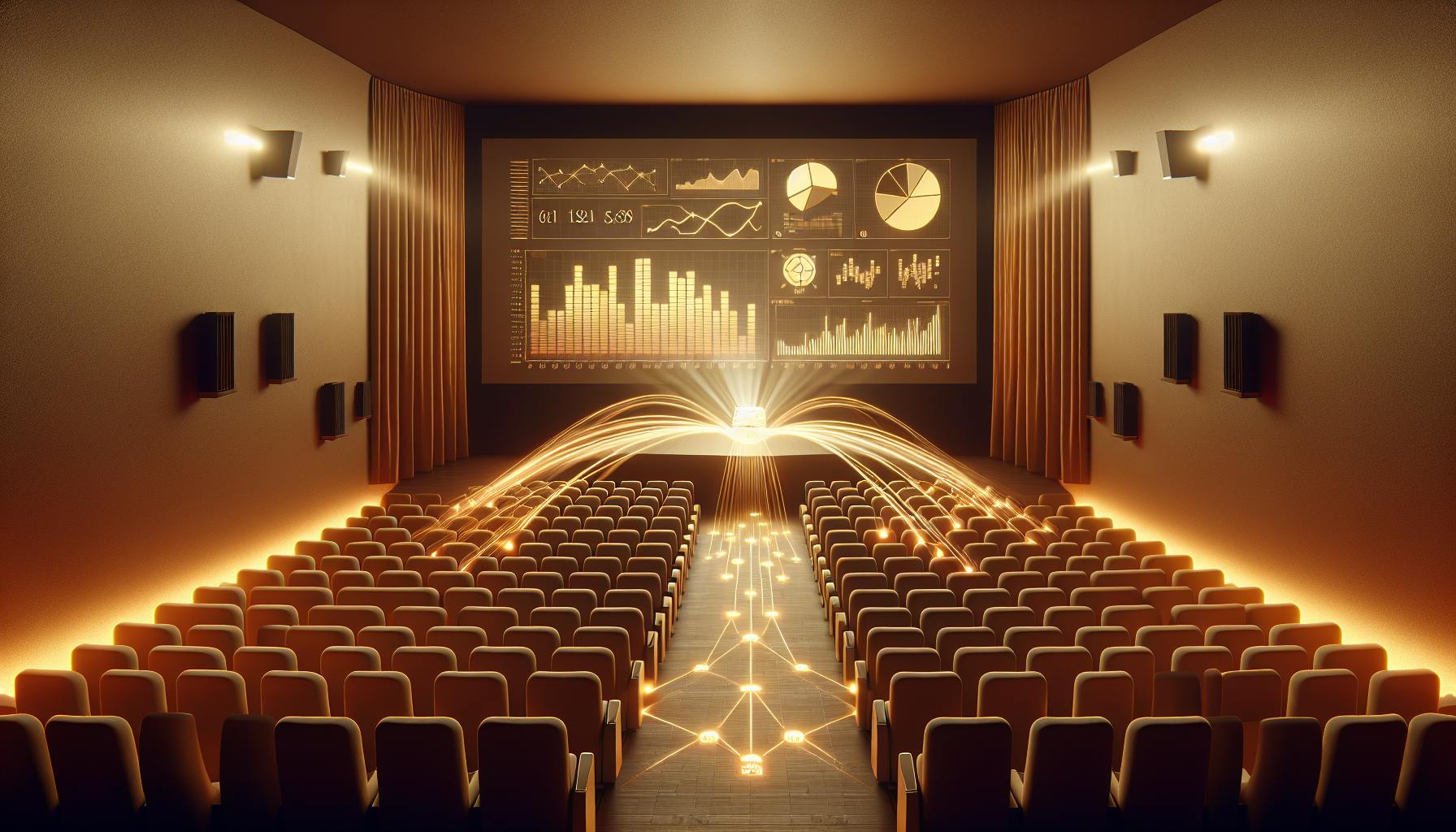Spatial audio is revolutionizing the movie theater experience, making sound more realistic and immersive than ever before. Instead of just surrounding you with sound, it precisely places each sound in a 3D space, putting you right in the middle of the action.
Here's how spatial audio is changing cinema sound:
- Creates a lifelike, engaging soundscape
- Precisely syncs sound with visuals
- Uses sound to guide emotions and attention
- Offers a unique experience you can't get at home
But bringing spatial audio to theaters comes with some challenges:
- Designing rooms for optimal sound
- Integrating new tech with existing systems
- Producing and distributing spatial audio content
To overcome these hurdles, the cinema industry needs to focus on:
- Careful speaker placement and acoustic treatment
- Standardized formats and tech for seamless integration
- Supporting filmmakers with tools and education
As spatial audio technology advances, it will offer exciting new possibilities for cinemas, like:
- Ultra-precise sound placement with next-gen formats
- Seamless integration with visuals for total immersion
- Personalized audio experiences for each moviegoer
- Improved accessibility for hearing-impaired viewers
Filmgrail is at the forefront of bringing spatial audio innovations to theaters. With their expertise in cinema solutions and focus on enhancing the moviegoing experience, Filmgrail is well-positioned to help cinemas harness the power of spatial audio and deliver unforgettable immersive experiences to audiences.
Related video from YouTube
How Spatial Audio Works
Traditional surround sound systems create an enveloping audio environment by sending different sounds to speakers placed around the room. Spatial audio takes this further by precisely positioning sounds in a 3D space.
It uses advanced software to map out the location of each sound object - dialogue, sound effects, music elements, etc. - and render them accurately in the audio mix. The sounds can then be placed and moved anywhere in the 3D space, creating a sense of height, depth, and movement that matches the on-screen visuals.
This spatial audio data is encoded into the movie's audio track. When played back through a spatial audio system in the cinema, the sounds are rendered in precise 3D locations, immersing the audience in a sphere of realistic, directional audio.
How Spatial Audio Works
Spatial audio creates a 3D sound environment that makes movie audio feel more realistic. Instead of just surrounding you with sound, it places each sound in a precise location, making you feel like you're right in the middle of the action.
| Regular Surround Sound | Spatial Audio |
|---|---|
| Sounds come from speakers around the room | Sounds come from exact locations in 3D space |
| Limited sense of height and depth | Sounds have height, depth, and movement |
| Sound locations are fixed | Sound locations can change dynamically |
Here's how spatial audio works:
- Sound Elements: Individual sounds like dialogue, effects, and music are created.
- 3D Positioning: Software is used to place each sound in a 3D space, giving it exact coordinates.
- Audio Mixing: The sounds are mixed together, with each one in its precise 3D location.
- Encoding: The 3D audio data is encoded into the movie's audio track.
- Playback: In the cinema, the sounds are played back from their exact locations, creating an immersive 3D audio experience.
Spatial audio makes movie sound more lifelike and engaging by:
- Creating a realistic 3D audio environment
- Syncing sound precisely with on-screen visuals
- Using sound creatively to guide attention and evoke emotions
- Providing a unique cinema experience compared to home viewing
As this technology improves, spatial audio offers exciting opportunities for cinemas to create more engaging and memorable movie experiences. By using spatial audio, theaters can offer audiences a level of immersion that brings stories to life like never before.
Challenges in Using Spatial Audio for Cinemas
Bringing spatial audio to movie theaters comes with some hurdles that need to be addressed to give viewers the best immersive sound experience. These challenges involve the theater design, technology integration, and content production and distribution.
Room Design and Setup
The shape and size of the theater room can greatly affect how well spatial audio works. The ideal room layout needs to be determined to minimize echoes and ensure even sound distribution throughout the space.
Speaker placement is also crucial. The number, type, and location of speakers must be carefully planned to accurately recreate the intended 3D soundscape based on factors like room size and seating arrangements.
Proper acoustic treatment is essential to control echoes and maintain sound quality. This may involve using special materials like sound-absorbing panels and bass traps strategically placed around the room.
Technology Integration
Spatial audio systems often require specific hardware like specialized speakers, amplifiers, and processors. Making sure these components work seamlessly with existing cinema equipment can be complex and may require upgrades or modifications.
Software compatibility can also be an issue. Spatial audio formats and codecs may not work well with older cinema software systems. Integrating new spatial audio technologies into existing content management, playback, and control systems can be challenging.
Precise calibration and tuning are needed to ensure accurate sound reproduction and optimal performance. This process can be time-consuming and requires specialized expertise, making it difficult for cinemas to maintain consistent audio quality across multiple screens.
Content Production and Distribution
Creating spatial audio mixes requires specialized tools, workflows, and expertise. Sound designers and mixers need to adapt their techniques to effectively utilize the capabilities of spatial audio formats, ensuring that the intended 3D soundscape is accurately captured and translated.
With multiple spatial audio formats and technologies available, ensuring compatibility across different cinema systems can be challenging. Lack of standardization in the industry can lead to inconsistencies in the audio experience across different theaters.
Distributing spatial audio content to cinemas requires efficient and reliable delivery mechanisms. Ensuring that the spatial audio mix remains intact and synchronized with the visual content throughout the distribution process is crucial to maintain the intended immersive experience.
Addressing these challenges requires close collaboration between cinema owners, technology providers, content creators, and industry stakeholders. By working together to establish best practices, standardize formats, and develop innovative solutions, the cinema industry can overcome these hurdles and provide moviegoers with unparalleled immersive experiences through spatial audio.
sbb-itb-b1b0647
Making Spatial Audio Work Better in Movie Theaters
To get the most out of spatial audio in cinemas, we need to focus on three key areas: room design, technology standards, and support for content creators.
Better Room Design for Spatial Audio
The shape and size of the theater room can affect how well spatial audio works. To create the best listening experience, theaters need to carefully plan:
- Speaker Placement: Where speakers are located in the room, based on factors like room size and seating arrangements. This ensures even sound distribution.
- Acoustic Treatment: Using special materials like sound-absorbing panels and bass traps to control echoes and maintain sound quality.
With proper acoustic planning and treatment, cinemas can create a controlled audio environment that allows spatial audio to shine.
Standardized Spatial Audio Technology
For spatial audio to work seamlessly across different cinema systems, we need industry-wide standards. Here's how we can achieve this:
- Collaborate on Formats and Protocols: Work with industry groups to develop and promote universal spatial audio formats and protocols.
- Ensure Compliance: Encourage manufacturers to follow these standards in their products, and establish certification programs to verify compliance.
- Provide Guidelines: Offer clear guidelines and best practices for implementing spatial audio systems in cinemas.
Standardization will reduce compatibility issues and ensure a consistent spatial audio experience for moviegoers, no matter which theater they visit.
Supporting Spatial Audio Content Creation
To keep spatial audio content flowing, we need to empower filmmakers and sound designers. Here are some ways to do that:
- Training and Education: Offer workshops and programs to teach spatial audio techniques and workflows.
- Access to Tools: Make it easier for content creators to access the necessary tools and equipment for spatial audio production.
- Collaboration and Showcasing: Create platforms for creators to share knowledge, collaborate on projects, and showcase their exceptional spatial audio works.
By investing in the content creation ecosystem, we can ensure a steady supply of engaging spatial audio experiences that will keep audiences coming back to cinemas.
Working together to improve room design, standardize technology, and support content creators, we can unlock the full potential of spatial audio and deliver truly immersive cinematic experiences to moviegoers.
The Future of Spatial Audio in Movie Theaters
Spatial audio technology is rapidly improving, and it has the potential to greatly enhance the moviegoing experience. In the future, movie theaters will benefit from exciting advancements that will make audio more realistic, engaging, and satisfying for audiences. Filmgrail is well-positioned to take advantage of these innovations and provide cutting-edge audio solutions in cinemas.
New Spatial Audio Formats
New spatial audio formats will offer better sound localization, allowing for more precise placement and movement of sounds in 3D space. With more channels and higher spatial resolution, filmmakers will have greater control over the audio environment, enabling them to create incredibly realistic and immersive soundscapes.
| Format | Channels | Spatial Resolution |
|---|---|---|
| Current Formats | 7.1 - 22.2 | Medium |
| Next-Gen Formats | 32+ | High |
These next-gen formats will also introduce new features like:
- Dynamic Sound Rendering: Sounds will adapt in real-time based on the listener's position and movement in the theater.
- Interactive Audio: Viewers will be able to interact with the audio environment, creating personalized experiences.
- Intelligent Sound Mapping: Sound placement will be automatically optimized for each theater room's unique acoustics.
These advancements will allow Filmgrail to deliver unparalleled audio experiences that truly transport audiences into the heart of the story.
Integration with Visual Technologies
In the future, spatial audio will be deeply integrated with visual technologies like high-resolution visuals, 3D projection, and virtual/augmented reality. This will create a seamless and highly immersive experience where the boundaries between sound and visuals blur.
For example, the sound of a flying object could not only move around the theater space but also appear to interact with the visuals on the screen. This audio-visual synergy will heighten the sense of presence and make the movie world feel more tangible and believable.
Filmgrail's expertise in developing custom cinema solutions positions them to effectively integrate spatial audio with cutting-edge visual technologies. By offering comprehensive audio-visual packages, Filmgrail can help cinemas deliver truly transformative experiences that captivate audiences.
Personalized Audio Experiences
In the future, spatial audio will enable personalized audio experiences within the cinema setting. With advancements in binaural rendering and head-tracking technologies, it will be possible to deliver tailored audio to individual viewers based on their specific location and orientation within the theater.
This means that each audience member can experience the sound from their unique perspective, enhancing the sense of immersion and making the audio feel more natural and realistic. Personalized audio can also cater to individual preferences, allowing viewers to adjust the balance between dialogue, effects, and music to suit their liking.
Filmgrail's focus on moviegoer engagement aligns perfectly with the concept of personalized audio experiences. By leveraging these technologies, Filmgrail can help cinemas offer a new level of customization and interactivity, making each visit to the theater a unique and memorable event.
Accessibility and Inclusion
Spatial audio innovations will also play a vital role in improving accessibility and inclusion in movie theaters. By providing precise sound localization and enhanced clarity, spatial audio can greatly benefit viewers with hearing impairments or those who rely on audio description services.
With the ability to place dialogue, sound effects, and audio descriptions in specific locations within the 3D space, spatial audio can improve intelligibility and make the movie experience more accessible to a wider audience. This aligns with Filmgrail's mission to create inclusive and engaging experiences for all moviegoers.
As the future unfolds, Filmgrail is poised to be at the forefront of spatial audio advancements in the cinema industry. By embracing these innovations and integrating them into their solutions, Filmgrail can empower cinemas to deliver unrivaled immersive experiences that captivate audiences, drive engagement, and solidify the cinema as the ultimate destination for unforgettable storytelling.
Summary
Spatial audio can make movie sound much better and more realistic. It places sounds all around you, making you feel like you're in the middle of the action. But there are some challenges in using spatial audio in movie theaters.
Filmgrail wants to help movie theaters overcome these challenges. With better spatial audio, movie theaters can:
- Make movie sound more lifelike and engaging
- Make the movie experience better than watching at home
- Attract more people to visit the theater
- Use the latest audio technology
Here are the main challenges and how to solve them:
Room Design
- Place speakers carefully based on the room size and seating
- Use special materials to control echoes and improve sound quality
Technology
- Work with others to create standard formats that all theaters can use
- Make sure equipment and software work well together
Content Creation
- Teach filmmakers and sound designers how to create spatial audio
- Give them access to the right tools and equipment
- Let them share ideas and showcase their work
By improving room design, using standard technology, and supporting content creators, movie theaters can get the most out of spatial audio.
As spatial audio keeps getting better, it will offer exciting new ways to make the movie experience even more engaging and enjoyable. From personalizing audio for each viewer to making audio more accessible, the future of spatial audio in theaters looks promising.
Filmgrail is well-positioned to lead the way in bringing spatial audio to movie theaters. With their expertise in cinema solutions and focus on improving the moviegoing experience, Filmgrail can help theaters stay ahead of audio innovations and give audiences unforgettable cinematic experiences.
FAQs
What are the benefits of spatial audio?
Spatial audio makes movie sound more realistic and engaging. It places sounds all around you, making you feel like you're right in the middle of the action. Here are some key benefits:
- Immersive sound: You'll feel surrounded by the movie's sounds, drawing you deeper into the story.
- Heightened emotions: Precise sound placement can intensify emotional scenes and make you feel more connected.
- Improved clarity: It's easier to distinguish different sounds like dialogue, effects, and music.
- Theater advantage: Spatial audio gives cinemas an edge over watching movies at home, encouraging more people to visit.
Is spatial audio good for watching movies?
Yes, spatial audio greatly enhances the movie-watching experience in theaters. It makes the sound more lifelike and immersive by:
- Creating a realistic soundscape that surrounds you
- Syncing sounds perfectly with on-screen visuals
- Using sound creatively to guide your attention and evoke emotions
- Providing a unique cinema experience that you can't get at home
Spatial audio makes watching movies in theaters more engaging, memorable, and satisfying.
What devices work best with spatial audio?
Spatial audio works best with these devices:
| Device | Compatible |
|---|---|
| AirPods Pro (1st or 2nd gen) | ✓ |
| AirPods Max | ✓ |
| AirPods (3rd gen) | ✓ |
| Beats Fit Pro | ✓ |
| Beats Studio Pro | ✓ |
| iPhone 7 or later (built-in speakers) | ✓ |
| Select iPad models (built-in speakers) | ✓ |
| Mac computers with Apple silicon (built-in speakers) | ✓ |
Make sure your device is running iOS, iPadOS 15.1, or later to use spatial audio.
How do you experience spatial audio?
To experience spatial audio on Android devices:
- Use headphones that support spatial audio with head tracking.
- Play content mixed in a spatial audio format.
- As you turn your head, the sound will stay positioned around you.
- For example, if a bird is chirping to your right and you turn left, you'll hear it in front of you.
This head-tracking feature makes spatial audio feel more natural and immersive.
What are tips for mixing spatial audio?
When mixing spatial audio for cinemas, consider these tips:
- Match sound to visuals: Make sure the sound source matches what's on screen for a consistent experience.
- Use spatial audio consistently: Avoid turning it on and off, as it can be distracting. Use it throughout for atmosphere and emphasis.
- Balance the soundscape: Distribute sounds effectively in the 3D space to create a balanced, immersive environment.
- Precise sound placement: Place sounds precisely in the 3D space to draw attention, guide focus, and enhance the story.
- Test in different setups: Listen to your mix in various cinema setups to ensure it translates well across different systems and acoustics.
Following these tips can help you create engaging and immersive spatial audio mixes that elevate the cinematic experience for your audience.


